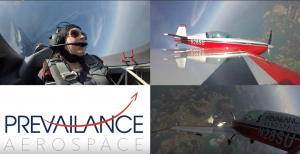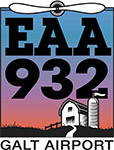 Back in September, I had the opportunity to do Upset Recovery Training with Prevailance Aerospace. I’m in my sophomore year at Liberty University and we have an opportunity to work with Prevailance during Commercial 2 for Upset Recovery Training and also during CFI for Spin Recovery. Preparation for the flights began the night before as most of us are not used to aerobatic maneuvers regularly. We were instructed to get a good night of sleep and drink lots and lots of water and a pretty neutral breakfast. I usually just stuck with a bagel. During the morning before each flight, we went over safety presentations to learn the reasoning behind this training. A common accident that could occur in a C172 is getting into wake turbulence landing behind a jet at a large airport and we now know how to get out of it. We learned about some previous accidents that have occurred and how they could have been easily prevented with the right training. We also had a flight briefing before each flight reviewing the maneuvers we would go over and the memory items. It was an incredible experience! We had three flights and increased the workload each day of the flight. We memorized an Upset Recovery checklist and went through
Back in September, I had the opportunity to do Upset Recovery Training with Prevailance Aerospace. I’m in my sophomore year at Liberty University and we have an opportunity to work with Prevailance during Commercial 2 for Upset Recovery Training and also during CFI for Spin Recovery. Preparation for the flights began the night before as most of us are not used to aerobatic maneuvers regularly. We were instructed to get a good night of sleep and drink lots and lots of water and a pretty neutral breakfast. I usually just stuck with a bagel. During the morning before each flight, we went over safety presentations to learn the reasoning behind this training. A common accident that could occur in a C172 is getting into wake turbulence landing behind a jet at a large airport and we now know how to get out of it. We learned about some previous accidents that have occurred and how they could have been easily prevented with the right training. We also had a flight briefing before each flight reviewing the maneuvers we would go over and the memory items. It was an incredible experience! We had three flights and increased the workload each day of the flight. We memorized an Upset Recovery checklist and went through  several unusual attitudes and aerobatic maneuvers in an Extra 300. I got to experience loops, barrel rolls, aileron rolls, spins, and lots of unusual attitudes. One of the goals of the training was to make us more comfortable knowing how to recover from any attitude and I can say that I understand now exactly what to do when upside down to get the plane back upright. I feel confident that I would be able to recover from any unusual attitude. The most difficult recovery was from inverted flight because it felt instinctive to pull the aircraft around to the horizon, whereas the correct response would be to push slightly to unload the aircraft and then roll wings around to level. I recommend that students pilots and private pilots complete this training or similar training because it prepares you for almost any situation and am thrilled to have had the opportunity to experience such instruction.
several unusual attitudes and aerobatic maneuvers in an Extra 300. I got to experience loops, barrel rolls, aileron rolls, spins, and lots of unusual attitudes. One of the goals of the training was to make us more comfortable knowing how to recover from any attitude and I can say that I understand now exactly what to do when upside down to get the plane back upright. I feel confident that I would be able to recover from any unusual attitude. The most difficult recovery was from inverted flight because it felt instinctive to pull the aircraft around to the horizon, whereas the correct response would be to push slightly to unload the aircraft and then roll wings around to level. I recommend that students pilots and private pilots complete this training or similar training because it prepares you for almost any situation and am thrilled to have had the opportunity to experience such instruction.
Q & A with Gretchen Thennes
What training/ratings do you have?
I got my instrument rating in May and I am currently working on my Commercial Certificate. I am hoping to have my Commercial Multi by May of 2020.
Any future goals?
My ultimate goal is a job with the airlines, as I love the environment and the schedule and I have grown up with my mom as an airline flight attendant.
What AGL were the maneuvers performed at? Did you have loss limits for recovery?
We performed the maneuvers between 5,000 MSL and 9,000 MSL and some maneuvers like the spins used the entire area! That’s about 4,000-8,000 AGL here in Virginia. Since most of the training was new, we did not have loss limits. The instructors ensured that we started high enough so we could lose a lot of altitude and mostly learn.
Had you worn a parachute before?
I hadn’t worn a parachute before. We talked about evacuating a lot and the instructors all had experience, so I felt it would be okay if we did have to pull the chutes.
How long was the typical flight? How many hours/flights do you now have in upset recovery?
Each flight was 1.0, so we took off, headed straight to the practice area, conducted the maneuvers, and the instructor landed when we got back. I have 3.0 hours in upset recovery and even that little time gave me so much experience, it was 3 hours full of learning!
Did you make any mistakes that taught you anything?
One mistake I made was trying to pull while rolling back to wings level in recovery and the Extra 300 can handle that kind of load, but most planes we typically fly cannot, so I had practice doing it the right way several times by rolling wings level and then pulling the nose back to the horizon.
Did the experience get you interested in aerobatics for fun?
I think aerobatics are really cool, but I don’t quite have the stomach for it now. The instructors said that you get more and more used to it, so I would like to go up with other people and experience more aerobatics, but I don’t think it would be something I would get really involved in. However, some of my classmates are really considering competing in the future!
Any other takeaways?
I think the biggest takeaway for me was learning about the countless accidents that have occurred because people have not had the right training. With simple fixes, several accidents may have been avoided.

